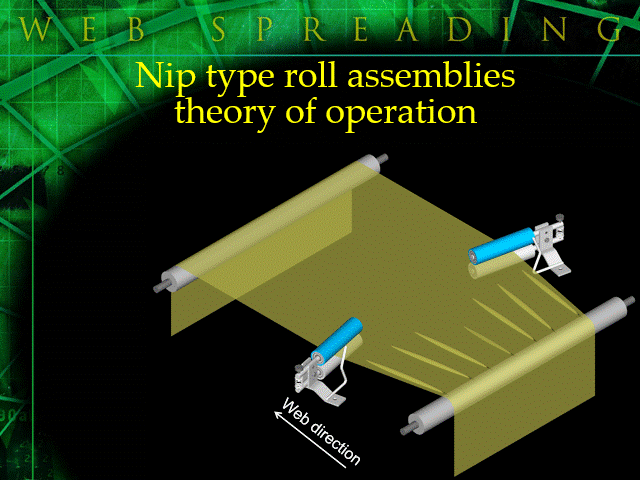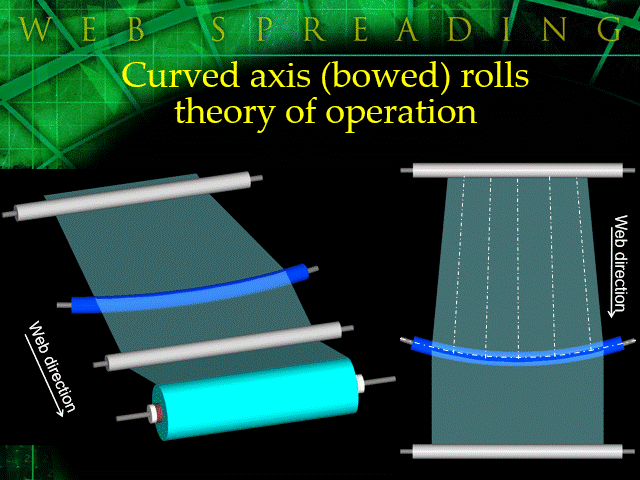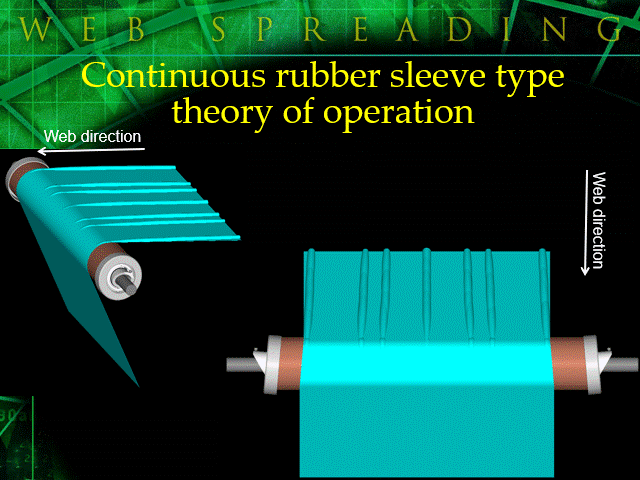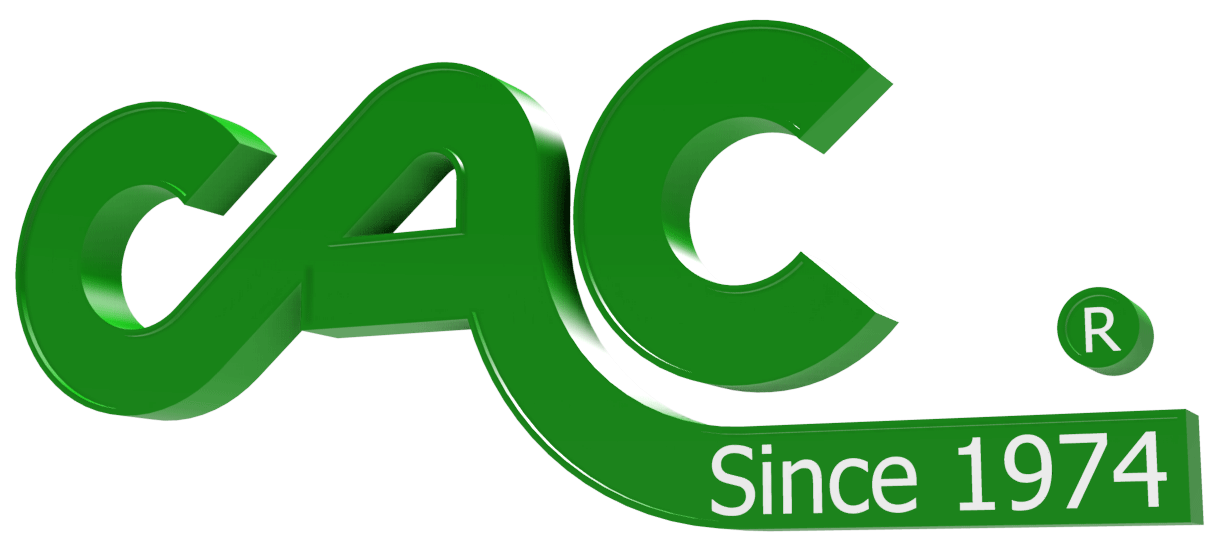Nip Type (each edge of the web) Spreader Roller System
Description:
Nip type spreader rollers are normally short face rollers (less than 12” face) and small diameter (less than 3” diameter). These rollers are supplied in a left and right hand set. Each set consists of 2 rollers pre-loaded so each roller face is pressed together; these roller faces must be parallel with each other. Each roller set is very similar in design to other nip rollers used in converting (such as drive nips). One of the rollers in each set must be rubber covered (for traction); sometimes both rollers in the set are rubber covered.
Theory of operation:
The left and right side nip sets are mounted to the machine frame and each edge of the web is fed through the nip rollers. The left and right side nip roller sets are then angled away from each other, facing in the down stream direction. Because of the web handling principle, that a web will seek to align itself perpendicular to a roller, in its entry span to that roller, each web edge will seek to be perpendicular to each nip roller set. This type of spreader roller is extremely aggressive and will remove more web wrinkles, more aggressively than any other type of anti-wrinkle system.
This type of spreader roller has no wrap angle. Because the web is not supported across its full width, the material must be fed straight in and out of this spreader roller assembly.

Main advantages:
● This type of anti-wrinkle system is the most aggressive.
● Simplicity of design makes this type of spreader roller easy to maintain.
● The amount of spreading is easily adjustable, by changing the angle of each nip set independently of each other.
Main disadvantage:
● Because this anti-wrinkle system does not support the web across its full width, it may mark or distort foils. Typically, this anti-wrinkle system is not used with foil webs.
Bowed rollers
Description:
A bowed roller is manufactured exactly as the name states – the center axle of the roller is bowed (not linear). A series of internal ball bearings, supported by the axle, in turn support a rubber sleeve which is continuous across the bowed roller face. The amount of curve (bow) in the roller face is application dependent and is available in both an adjustable and non-adjustable versions.
Theory of operation:
This roller works based on two different web spreading principles.
First, as we know, a web will seek to align itself perpendicular to this roller (as long as it is in traction with the roller). This causes the web to spread at any given interval across its width as it tries to maintain the 90° tangent points across the curved axis of the bowed roller face width.
Second, the rubber sleeve, which spans the roller face, is narrower on the entry side of the roller than the exit side, so as it rotates, the rubber sleeve stretches and the material, laying on top of the rubber surface, stretches with the rubber sleeve.
Because this roller normally operates best with minimal wrap angle, the first spreading principal does most of the work. Less surface contact between the web and the rubber sleeve means less stretching principal will effect overall spreading. However, the spreading based on web handling principle is hardly affected by wrap angle.

Recommended wrap angle is usually less than 30°. Many times, when it appears a bowed roller is not operating properly, this is due to wrap angles to great for the application. More important than wrap angle, lead-in and lead-out distances are critical. Typical lead-in (entry span) to the curved axis (bowed) roller should be approximately double the lead-out distance (exit span). As you can see in the illustration, most of the spreading caused by this roller is done in the entry span to this roller, so the longer the entry span is, the more web wrinkles will be eliminated. The exit span should be kept short so the web stays spread. The longer the exit span is, the more chance there is for the spreading affect to be lost (or the web may return to its wrinkled or natural state).
Main advantages:
● This type of spreader roller is an aggressive anti-wrinkle device.
● Bowed rollers are very common. They are accepted for all facets of converting from narrow web to wide web (it is especially used in wide web applications) and slow speed to high speed.
● This type of spreader roller is used with all types of webs in all types of converting processes.
● This roller has a smooth surface, so it will not mark or scratch the surface of the web.
Main disadvantages:
● Bowed rollers are not linear, so they can permanently distort the center of some webs. Because web tension is not evenly distributed across the face of bowed rollers, added tension delivered to the center of the web (due to curved shape of the bowed roller) may cause this distortion.
● When maintenance is required this roller is normally returned to the bowed roller manufacturer.
● Because the rubber sleeve is dynamic (it constantly stretches and contracts with each revolution) the rubber sleeve does wear over time.
Expanding Surface Anti-Wrinkle Roller
Description:
This type of anti-wrinkle roller is manufactured with a rubber sleeve stretched across its face. On each end of the rubber sleeve there are end collars that clamp and hold the sleeve in place. The end collars are mounted on bearings and an adjustable axle. The sleeve is mounted across a series of flexible rubber disks. The rubber sleeve and end caps rotate together.
Theory of operation:
This roller must be incorporated as a dead shaft idler roller, in order to operate properly. The continuous rubber sleeve is pre-loaded across the face of the roller. The end collars are clamped on to each end of the rubber sleeve. The end collars are then canted with an adjustment screw and flange-axle assembly. The canting adjustment is designed so that the collars are facing each other on one side of the roller face and they are away from each other on the opposite (180°) side of the roller. The continuous rubber sleeve stretches from the point where the collars are facing each other, to where the collars are away from each other. The sleeve then contracts for the next 180° of rotation, from where the end collars are facing away from each other to where they are facing toward each other. Bottom line, the rubber sleeve physically stretches from the short side of the rubber sleeve to the long side of the rubber sleeve, then contracts again. The web enters the contracted side of the rubber sleeve and exits on the expanded side. As this roller rotates, the stretching action of the rubber sleeve eliminates wrinkles from the web.

Recommended wrap angle for this roller is from 90° to 180°. More wrap (up to 180° maximum) means more wrinkle removal. The amount of web spreading is directly proportional to the amount of wrap angle. In other words 180° of wrap will provide for 100% of possible spreading, 90° of wrap will provide 50% of possible spreading, 45° of wrap will provide 25% of possible spreading, etc. Lead-in and lead-out distances are not critical in the application of this type of anti-wrinkle device, because all or most of the web spreading is taking place on the roller face, not in the entry span to the roller.
Main advantages:
● This type of anti-wrinkle system is an aggressive wrinkle eliminating device.
● Anti-wrinkle aggression is adjustable from 0% (no spreading) - 100%. Adjustment can be made while the web is running with standard tools. Each side of the roller is independentally adjustable.
● This roller is linear across its face, so tension remains evenly distributed across the roller face. So, this roller will not distort your web.
● Roller surface is smooth and linear so it will not mark, scratch or deform a web.
● This roller is used with all types of webs.
Main disadvantages:
● Web speeds are a consideration when utilizing this roller. If the web speed causes the sleeve to balloon, as a result of centrifugal force, then the roller may not operate properly.
● The sleeve is stretching and contracting with every revolution, so the continuous rubber sleeve will degrade over time.
News No. 55
 (800) 433-2413
(800) 433-2413

 Please wait
Please wait




